Статьи журнала - Журнал стресс-физиологии и биохимии
Все статьи: 984
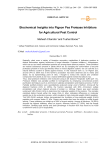
Biochemical insights into pigeon pea protease inhibitors for agricultural pest control
Статья научная
Basically, plant uses a variety of bioactive secondary metabolites & defensive proteins to defend themselves against herbivores & fungal diseases. Protease inhibitors / Antiprotease, which can act as insect antifeedant proteins are among these defence proteins. These inhibitors are natural substances present in plants which act by changing the conformation of enzyme proteases present in insect gut thereby effect on insect digestive system; we can call this as a natural defence system of plants against insects. In this research work i.e. on Pigeon pea, around 14% to 100% loss in the farmer’s production has been observed due to insect pest attack. So by epistemology point of view, I thought to extract this natural anti -protease compounds from plants & use it as a natural defendant against insects that attack crop. Thus, total protease inhibitors were extracted using 0.1M Sodium Phosphate buffer (pH 7.5). Protease inhibitor was partially purified to homogeneity by employing conventional protein purification techniques such as Ammonium sulphate precipitation and Dialysis process. Further Partially purified proteins were quantitatively analyzed using Lowry’s Method. Among all the dialyzed fractions (10% to 100%), the fraction saturated with 60% Ammonium sulfate precipitation salt shown highest amount of protein i.e. 4924ug. Pigeon pea seed samples underwent SDS-PAGE (15%) to determine the molecular weights of the proteins. The samples exhibited distinct bands within the range (245-11 kDa), indicating differences in molecular weight due to the extraction process, which resulted in high-molecular-weight (HMW) peptides. The SDS-PAGE analysis further demonstrated the formation of low-molecular-weight (LMW) peptides with masses below 12 kDa. Pigeon pea seeds also have the ability to inhibit trypsin activity. These inhibitors can inhibit up to 59% of trypsin activity. Among all fractions, F6 (60%) showed the highest inhibitory effect on trypsin, whereas fraction F2 (20%) had the lowest inhibition. Similarly total activity and yield percentage in fraction 60% was found to be 4038 umol/min/ml and 83.25 % respectively.
Бесплатно
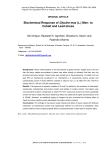
Biochemical response of Glycine max (L.) Merr. to cobalt and lead stress
Статья научная
Background: Heavy metal pollution of soil has become a global concern, largely due to the fact that the heavy metals accumulated in plants may either directly or indirectly find their way into animals and human beings. Present study was carried out on the phytotoxicity of cobalt (Co) and lead (Pb) on biochemical constituents viz. chlorophyll a, b, carotenoids, proline, protein and carbohydrate content of three different varieties of Glycine max viz. SL-688, PS-1347, DS-9712 treated with 50, 100 and 150 µM concentrations. Results: The exposure of soybean varieties to Pb and Co resulted in the reduction of chlorophyll, carotenoids, carbohydrate and protein content and addition in proline content. Test plants were more sensitive to lead in comparison to cobalt. PS-1347 variety was found to be more susceptible to both the heavy metals. Maximum deleterious effect was observed at higher concentrations (100 & 150µM). However, an additional supply of nitrogen not only minimized the inhibitory effect of these two heavy metals but also decreased the proline content of plants. Conclusions: The findings of the present study indicate that effect of heavy metals with different treatments on biochemical content was significantly different at 0.05 level of probability. Soils contaminated by heavy metals probably lead to substantial losses in seed yield of soybean plant.
Бесплатно
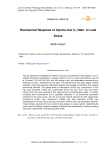
Biochemical response of Glycine max (L.) Merr. to lead stress
Статья научная
This pot experiment investigated the effects of varying concentrations of lead acetate in soil on selected biochemical parameters in soybean ( Glycine max (L.)), Lead concentrations were set at 0 (control), 200, 400, 600, 800, and 1000 mg/kg of soil, with observations recorded at pre-flowering (30 days), peak-flowering (45 days), and post-flowering (60 days) stages. Results indicated a clear dose-response relationship between lead acetate concentration and soybean biochemical attributes. The highest levels of chlorophyll-a (0.6287 mg), chlorophyll-b (1.0193 mg), total chlorophyll (1.6480 mg), carbohydrate (53.04 mg), lipid (43.23 mg), and protein content (9.00 mg) were recorded at 200 mg/kg during the post-flowering stage. In contrast, increasing lead concentrations led to significant reductions in all biochemical parameters compared to the control group, with the most severe impacts observed at 1000 mg/kg where chlorophyll-a (0.2961 mg), chlorophyll-b (0.4889 mg), total chlorophyll (0.7850 mg), carbohydrate (27.08 mg), lipid (33.92 mg), and protein content (3.897 mg) significantly declined. These findings underscore the toxic impact of lead acetate on soybean growth, highlighting the urgent need for effective mitigation strategies to address lead contamination, thereby promoting agricultural sustainability and protecting public health.
Бесплатно
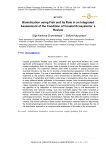
Статья обзорная
Coastal ecosystems located near cities, industrial and agricultural facilities are under significant anthropogenic influence. The complexity of modern anthropogenic impact on coastal ecosystems does not always make it possible to determine the quantitative content of all pollutants. The traditional methods used make it possible to assess physical and chemical indicators, but they do not provide a comprehensive assessment of the impact on the biological system. The use of bioindication methods that reflect the response of aquatic organisms to the complex influence of the environment is extremely relevant. Fish are a large group of vertebrates and inhabit a wide range of ecosystems where they are exposed to many different aquatic pollutants. In bioindication studies, both morphophysiological and biochemical indicators of fish are widely used. The use of morphophysiological indicators makes it possible to assess the impact of environmental factors on the organism, as well as the specifics of its adaptation to environmental changes. Due to the development of biochemistry and molecular biology, such new techniques appear that make it possible to determine the impact of an environmental factor at those stages when changes occur at the cellular, membrane and molecular levels, and do it before this impact leads to irreversible pathological processes. The use of bioindication methods, that reflect the reaction of biota to the entire complex of negative environmental influences, is a relevant and promising method. The review examines in detail modern bioindication methods based on determining the morphophysiological and biochemical parameters of fish, and also assesses the role of the bioindicator approach in a comprehensive assessment of the state of the environment.
Бесплатно
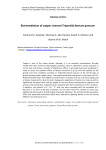
Bioremediation of copper stressed Trigonella foenum graecum
Статья научная
Copper is one of the heavy metals, although it is an essential microelement through interference with numerous physiological processes, when it absorbed in excess amounts, it can be toxic and induce a number of deleterious effects. A pot experiment was conducted in order to assess the possible effects of Nostoc muscorum (2 g/ kg soil fresh pellets) on the growth and some metabolic activities of Trigonella foenum gracum at 30 and 60 days of growth growing under copper stress. This experimental plant was grown in clay-sandy soil (2:1 W/W) amended either with different concentrations of CuSO 4 (0.4, 0.6, 0.8 and 1.0 g/kg soil) or Nostoc mixed with Cu (0.6, 0.8 and 1.0 g/kg soil). Application of Nostoc in a mixture with Cu significantly increased fresh and dry weight of root and shoot, photosynthetic pigments and activity at 30 and 60 days of growth when compared with their counterparts of Cu treatment. In addition, the content of K +, Ca 2+, P 3+ and iron were increased with the exception of a decrease in Cu level at 60 days of growth. On the other hand, the content of starch was significantly decreased at 30 and 60 days of growth. Moreover, the activity of both peroxidase (POD) and superoxide dismutase (SOD) were reduced by applying Nostoc to the soil having different concentrations of Cu.
Бесплатно

Body mass, thermogenesis and energy metabolism in Tupaia belangeri during cold acclimation
Статья научная
In order to study the relationship between energy strategies and environmental temperature, basal metabolic rate (BMR), nonshivering thermogenesis (NST), the total protein contents, mitochondrial protein contents, state Ⅲ and state Ⅳ respiratory ability, cytochrome C oxidase activity of liver, heart, diaphragm, gastrocnemius and brown adipose tissue (BAT), serum leptin level and serum thyroid hormone levels were measured in tree shrews (Tupaia belangeri) during cold exposure (5±1oC) for 1 day, 7 days,14days,21 days. The results showed that body mass increased, BMR and NST increased, the change of liver mitochondrial protein content was more acutely than total protein. The mitochondrial protein content of heart and BAT were significantly increased during cold-exposed, however the skeletal muscle more moderate reaction. The state Ⅲ and state Ⅳ mitochondrial respiration of these tissues were enhanced significantly than the control. The cytochrome C oxidase activity with cold acclimation also significantly increased except the gastrocnemius. Liver, muscle, BAT, heart and other organs were concerned with thermoregulation during the thermal regulation process above cold-exposed. There is a negative correlation between leptin level and body mass. These results suggested that T. belangeri enhanced thermogenic capacity during cold acclimation, and leptin participated in the regulation of energy balance and body weight in T. belangeri.
Бесплатно
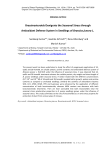
Статья научная
The present work has been undertaken to study the effect of exogenously application of 24-epiBL and 28-homoBL on soluble protein, proline contents and antioxidant defense system of Brassica juncea L. RLM 619 under the influence of seasonal stress. It was observed that 24-epiBL and 28-homoBL treatment enhance the soluble protein, dry weight and shoot length of B. juncea seedlings under seasonal stress. If seeds treated with the different concentrations (10 -6, 10 -8 and 10 -10 M) of 24-epiBL and 28-homoBL revealed batter growth, protein and proline contents as compare to untreated seedlings. Similarly the activities of antioxidant enzymes SOD, CAT, APOX, DHAR, PPO and Auxinases were enhanced by the application of different concentration of both brassinosteroids, whereas MDA content was decrease with both brassinosteroids treatments. Then we have concluded that both brassinolides have the seasonal stress ameliorative properties in B. juncea seedlings grown under the influence of seasonal stress. This study culminates to the role of brassinolides as an anti-stress property for protection of plant from various types of stresses.
Бесплатно
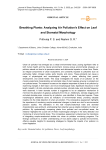
Breathing plants: analyzing air pollution’s effect on leaf and stomatal morphology
Статья научная
Urban air pollution has emerged as a critical environmental issue, posing significant risks to both human health and the natural environment. Among various environmental stressors, air pollution stands out due to its pervasive nature and detrimental impacts on urban flora. Plants, as integral components of urban ecosystems, are constantly exposed to pollutants such as particulate matter, nitrogen oxides, sulfur dioxide, and ozone. These pollutants can cause a range of physiological and morphological changes in plants, affecting their growth, development, and overall health. This study investigates the impact of air pollution on the morpho-anatomical characteristics and stomatal index of plant species growing in polluted and non-polluted areas. The research focuses on the adaptive responses of plants to air pollution by examining changes in leaf macro- and micro-morphological traits. Significant reductions in leaf length, breadth, L/B ratio, stomata size, stomata number, stomata index, and stomata frequency were observed. A lower stomata number is suggested to be an adaptation mechanism to minimize the absorption of gaseous pollutants from the air. Additionally, stomata clogging with occluded stomata pores, induced by air pollution, was identified in three plant species. These morphological alterations serve as indicators of environmental stress, providing valuable insights into the initial detection of urban air pollution. This comparative assessment highlights the importance of monitoring morpho-anatomical changes in plants as a tool for environmental pollution studies. The alterations in the leaf morpho-anatomical traits and stomatal characteristics were profound, emphasizing their potential use as reliable indicators of urban air pollution. By systematically comparing plants from polluted and non-polluted areas, the research highlights the crucial role of these morphological changes in the early detection and monitoring of environmental stress. This comparative assessment underscores the importance of integrating morpho-anatomical studies into urban air pollution monitoring programs. The findings contribute to a better understanding of how plants adapt to polluted environments, offering valuable insights for developing strategies to mitigate the impacts of air pollution on urban vegetation.
Бесплатно
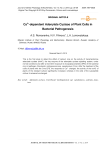
Ca2 + -зависимая аденилатциклаза растительных клеток в бактериальном патогенезе
Статья научная
Это первое исследование, в котором обнаружено влияние ионов кальция на активность трансмембранной аденилатциклазы (tmAC), ключевого фермента сигнальной системы аденилатциклазы, в нормальных условиях и после кратковременного воздействия экзополисахаридов (EPS) бактериальный кольцевой гниль, возбудитель Clavibacter michiganensis ssp. сепедоник (см). После обработки корней растений ЭПС Cms реакция на Ca2 + изменилась: активность tmAC растений устойчивого сорта значительно увеличилась, тогда как в клетках восприимчивого сорта она осталась неизменной.
Бесплатно
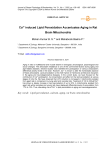
Ca2+ induced lipid peroxidation accentuates aging in rat brain mitochondria
Статья научная
Aging in rats is multifactorial and include decline in biological, physiological, psychological and social changes. The antioxidant imbalance is one of the commonest factors during aging and age-related diseases. Several studies have identified the participation of various antioxidant’s differential activity levels in the brain. However, Ca2+ is known to alter the homeostatic balance of these antioxidants. Lipid peroxidation is the chief marker of membrane architecture disruption in the aging and neurodegenerative diseases. In the current study, we have focused on the contribution of Ca2+ participation, its concentration and effect on the lipid peroxidation at various stages of rat’s life. We have observed that LPO induction is increased in mitochondria isolated from aged rats in comparison to young adult and neonatal rats. Treatment of 100 to 300uM Ca2+ has shown a steady increase in lipid peroxidation of up to 20% in mitochondria isolated from aged rats while neonates and young rats have displayed differential levels of peroxidation from 17% to 15%. Thus, alleviating role of Ca2+ in lipid peroxidation in aging and neurodegeneration.
Бесплатно
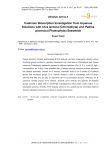
Статья научная
Fourier transform infrared spectroscopy (FTIR) analysis has been employed to identify various functional groups involved in cadmium biosorption into Ulva lactuca (Chlorophyta) and Padina pavonica (Phaeophyta) seaweeds exposed to different cadmium (Cd) (0, 2.5, 5 and 10 mg/L) concentrations for 4 days. Data revealed that Cd stress induced chemical structure alteration into studied seaweeds. Overall, for U. lactuca, carboxylic acids (C-O) & amides (C-N stretch) groups and aromatics groups (C-C stretch) showed a shift in wavelength with Cd stress referring that they may be play an important role in Cd biosorption process. Whereas, for P. pavonica, amides groups (C=O stretch), alcohols (O-H stretch) and phenols (H-bonded) groups showed a slight shift in wavelength indicating that these peaks could involve in Cd biosorption process. Thereby, FTIR analysis seems to be a potent tool for screening chemical structure alteration induced by Cd stress in marine ecosystems.
Бесплатно
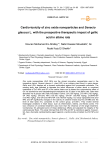
Статья научная
Zinc oxide nanoparticles (ZnO NPs) are the utmost innovative nanoparticles used in the imperative claims. Senecio glaucus L. plant (SP) is an ordinary plant found in warm places. Gallic acid (GA) displays as a dynamic antioxidant against the innumerable pollutants. The existing study was intended to appraise the lethal influences of either alone or combined treatments of ZnO NPs and SP in the cardiac tissue and to dissect the cytoprotective effect of GA via biochemical and histopathological evaluations for 30 days in the albino rats. Rats were allocated into 8 groups with orally inoculated: Control, GA (100 mg/kg), ZnO NPs (150 mg/kg), SP (400 mg/kg), GA+ZnO NPs (100,150 mg/kg), GA+SP (100,400 mg/kg), ZnONPs+SP (150,400 mg/kg), and GA+ZnO NPs+SP (100,150,400 mg/kg). Our study signposted that ZnO NPs and SP significantly changed in the activity of creatine kinase enzyme (CK-MB) and the level of total lipids (TL) compared to the control group, (p
Бесплатно
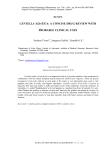
Centella asiatica: a concise drug review with probable clinical uses
Статья обзорная
Centella asiatica (Gotu kola) is an imperative herb in Ayurvedic medicine, often mentioned in combination with the related European marsh pennywort (Hydrocotyle vulgaris). About 20 species recounted to Gotu kola cultivate in most parts of the tropic or wet pantropical areas such as rice paddies and also in rocky and higher elevations. Centella asiatica (Gotu kola) is known as longevity herb and used widely in India and Nepal as part of the traditional Ayurvedic medicine. In Samskrita, it is called 'Mandūkaparnī' as its leaf appears as a standing frog from its backside. It is also called 'Brahmi the goddess of supreme wisdom and 'Saraswati the goddess knowledge & wisdom. Its roots and leaves are used for medicinal purposes and provide important health benefits related to healthy veins and blood vessels, to treat skin disorders, help with better memory and improve brain function.
Бесплатно
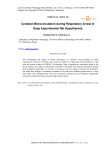
Cerebral Microcirculation during Respiratory Arrest in Deep Experimental Rat Hypothermia
Статья научная
We investigated the effect of breath stimulation on cerebral microcirculation at deep hypothermic condition of Wistar rats using the method for measuring microcirculation in real time and optical system of LUMAM-1 microscope. After a hypothermic respiratory arrest in the group without the usage of mechanical ventilation, the blood flow velocity decreases sharply and completely stops after 10 minutes. In the group with the usage of mechanical ventilation, the blood flow velocity is increased compared to the rate when breathing stops and for a long time stays at an elevated level. We have found that mechanical lung ventilation significantly improved cerebral blood flow and prolonged heart function.
Бесплатно

Статья научная
From an economic and toxicological point of view, Fusarium head blight (FHB), a biotic stress, is one of the most dangerous diseases of wheat and barley worldwide. It is recently known that humidity, an abiotic stress, enhances susceptibility of cereal heads to FHB infection and aggressiveness of Fusarium pathogens; however, whether its effect on pathogenicity in fungi and resistance in hosts is specifically or not is unknown. To end this, pot bio-experiments under natural climatic conditions during the growing season 2022/2023 were conducted to determine the nature of post-anthesis moisture influence on quantitative traits in FHB-wheat/barley interaction. Five durations of spray-irrigation of 0, 7, 14, 21, and 28 days, eight bread wheat, durum wheat and barley cultivars with different levels of FHB and 16 Fusarium isolates of various aggressiveness belonging to four FHB pathogens were involved under split-split-plot design. Evaluation of FHB quantitative traits to the variable watered conditions was through the quantification of Fusarium incidence, DI, Fusarium severity, DS, 21 days after inoculation as well as Fusarium -damaged kernel (FDK) percentages on harvested grain. Changeable watered conditions applied on plant materials of different resistance levels nonspecifically affected aggressiveness, DI, DS and FDK, of the tested Fusarium isolates whatever their pathogenic backgrounds (low, medium and high aggressiveness) and genetic origin (i.e., F. culmorum , F. solani , F. verticillioides , and F. equiseti ). The four susceptible responses, i.e., susceptible, susceptible to moderately susceptible, moderately susceptible and moderately resistant, did not vary also in their relative rankings in the eight tested cereal plants. From a grower’s perspective, prolonged rainy periods following wheat and barley flowering should be a signal to scout wheat and barely crops for FHB symptoms and mycotoxin accumulation, even if pre-flowering conditions were not conducive to FHB. This indicates for the first time that post-anthesis moisture nonspecifically affect development of Fusarium isolates in tissues of wheat and barley heads. Our results have obvious implications for disease epidemiology in complex relationship moisture, resistances of cultivars, and aggressiveness of Fusarium pathogens.
Бесплатно

Статья научная
In nature, plants are always subjected to various abiotic stresses such as drought, salinity, high temperatures and so on. Among these drought is a worldwide problem, responsible for limiting the growth, physiology and productivity of plants, thus has become a challenge for global food security towards growing population. Proso millet ( Panicum miliaceum L.) belonging to family Poaceae grows under wide environmental conditions and different soil profile. In this view, an experiment was conducted to investigate the range of tolerance and change of metabolic activities of Proso millet under drought stress. The control plants were irrigated regularly and treated plants were irrigated at 3, 5, 7, day intervals up to 60day interval drought (DAS). The root and leaf samples were collected on 30 DAS, 45 DAS and 60 DAS respectively for morphological and biochemical analysis. It was found that with increasing duration of water deficit, tremendous increases of antioxidants activities were recorded at all growth stages compared to control on 7DID at 60DAS. Furthermore, a decreased rate of growth, biomass and chlorophyll content was recorded in treated plants than control. Therefore, it can be concluded that proso millet has affinity to survive under prolonged drought stress and can help to understand the mechanism of photosynthetic efficacy for improving crop productivity.
Бесплатно

Статья научная
In order to study the influence of expression of heterologous genes of different origin ( cyp 11A1 and des C) on canola thermotolerance improvement on leaf membrane level the fatty acid composition was analyzed under short-time heat test. C yp 11A1 gene encodes cytochrome P450 SCC from bovine adrenal cortex mitochondria and was shown to affect the biosynthesis of steroid compounds. DesC gene encodes ∆9-acyl-lipid desaturase of cyanobacterium Synechococcus vulcanus. Decrease in palmitlinolenic acid content and index unsaturation as well as increase in total fatty acid and palmitic acid content were identified in cyp 11A1 canola in comparison with wild-type plants in stressfull conditions. But control and des C plants demonstrated similar changes in saturated (16:0), trienoic (16:3 and 18:3) fatty acid quantity, total fatty acid content and index unsaturation. Heterologous des C gene expression did not influence fatty acid composition and did not give advantages for plant under heat. Integration of cyp 11A1 gene in canola led to thermotolerance improvement on membrane level.
Бесплатно

Статья научная
In the present study, the effects of temperature changes during summer and winter seasons on haematological parameters, total cholesterol, and cortisol level in male and female Syrian Awassi sheep were studied. Blood samples were collected weekly from ten animals (five rams and five ewes) during August and January months (2022-2023), and these samples were analyzed by a Veterinary Hematology Analyzer to determine the haematological parameters, and by enzyme-linked immunosorbent assay technique (ELISA) to determine the level of cortisol and total cholesterol. The results showed that there were significant differences in white blood cells (WBC), monocytes (MON) and granulocytes (GRA), as well as in haemoglobin (HGB) between August and January for both females and males. No significant difference was recorded between the two months for both sexes regarding platelet count (PLT) and mean platelet volume (MPV). There were significant differences (P 0.05) was recorded for males between these two months. It was concluded that there were significant differences in the values of some blood components between summer and winter for males and females Awassi sheep, but the differences in the level of total cholesterol and cortisol were clearer in the females than in males between summer and winter. In general, this study showed the ability of the Syrian Awassi sheep to adapt higher temperature degrees than the lower ones in semi-arid area where Syrian Awassi flocks are raised.
Бесплатно

Changes in jasmonic and salicylic acids levels in barley challenged with cochliobolus sativus
Статья научная
Spot blotch (SB), caused by Cochliobolus sativus is a common foliar disease of barley worldwide. The phytohormones jasmonic acid (JA) and salicylic acid (SA) play important functions in plant defense systems. However, the changes in JA and SA pathways in response to SB disease have been poorly documented. In the current work and to better understand the mechanisms of barley resistance to this disease, JA and SA pathways were evaluated in resistant ‘Banteng’ and susceptible ‘WI2291’ cultivars across four time points post pathogen challenge. The data showed that JA and SA contents were elevated in fungus-inoculated and non-inoculated leaves in both resistant and susceptible interactions 24h post inoculation. However, although JA signaling was activated in parallel with SA signaling up to 72h in both cultivars, JA had no significant differences across four time points as compared with non-inoculated controls. Furthermore, the resistant cultivar ‘Banteng’ constitutively contained higher levels of SA (956.2 ng/g) comparing with the susceptible one ‘WI2291’ (192.5 ng/g) 96h post inoculation, whereas, JA pathway was weakly activated over time. We thus hypothesized that SA signaling has an important function in resistance mechanisms against SB disease, whereas JA signaling has a contrasting role in this defense system, which might prove crucial information concerning barley signaling events induced by C. sativus invasion.
Бесплатно


